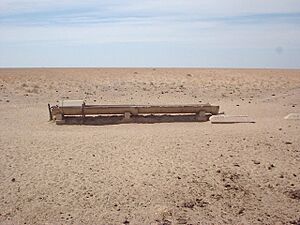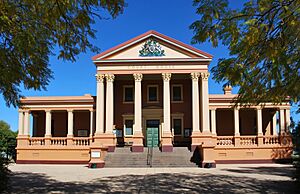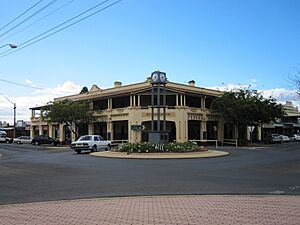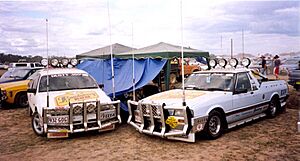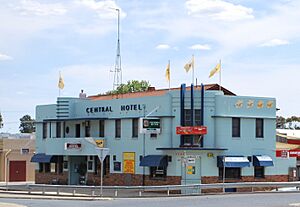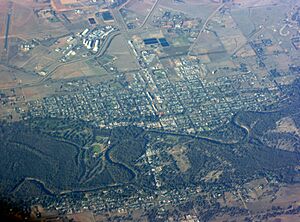Deniliquin facts for kids
Quick facts for kids DeniliquinNew South Wales |
|||||||||
|---|---|---|---|---|---|---|---|---|---|
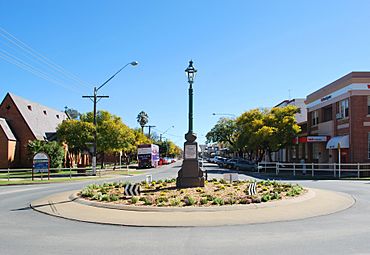
Deniliquin town centre
|
|||||||||
| Postcode(s) | 2710 | ||||||||
| Elevation | 93.0 m (305 ft) | ||||||||
| Location | |||||||||
| LGA(s) | Edward River Council | ||||||||
| County | Townsend | ||||||||
| State electorate(s) | Murray | ||||||||
| Federal Division(s) | Farrer | ||||||||
|
|||||||||
Deniliquin is a town in the Riverina region of New South Wales, Australia. It is very close to the border with Victoria. Deniliquin is the biggest town in the Edward River Council area.
The town is about 725 kilometres (450 miles) southwest of Sydney, the state capital. It is also about 285 kilometres (177 miles) north of Melbourne. The Edward River, which is a branch of the Murray River, divides the town into two parts. The main shops and businesses are on the south side of the river.
Deniliquin is a hub for farming. It is known for growing rice, producing wool, and its timber industry. In 2021, about 6,431 people lived in Deniliquin.
Contents
- Amazing Prehistory of Deniliquin
- Deniliquin's Rich History
- Historic Places in Deniliquin
- Deniliquin's Population
- What Deniliquin Makes and Does (Industry)
- Deniliquin's Climate
- Famous People from Deniliquin
- Schools and Learning in Deniliquin
- Sports in Deniliquin
- Deni Play on the Plains Festival
- Music Scene in Deniliquin
- Media in Deniliquin
Amazing Prehistory of Deniliquin
Did you know Deniliquin has a super old secret? It's named after a huge, hidden structure deep underground. Scientists think it's from a meteor crash over 400 million years ago! This giant impact might even be linked to a major extinction event that happened a long, long time ago.
Deniliquin's Rich History
Before Europeans arrived, the Aboriginal people called the Barapa Baraba lived in the Deniliquin area.
In 1843, a man named Benjamin Boyd bought land here. The spot was known as The Sandhills. Boyd named it Deniliquin after 'Denilakoon', a local Aboriginal person famous for his wrestling skills. An inn and a ferry (called a punt) were set up between 1845 and 1847. The town was officially surveyed in 1848 and became a gazetted town in 1850. The Deniliquin Post Office opened on January 1, 1850.
In 1853, William John Wills, who later became famous for the Burke and Wills expedition, worked as a shepherd near Deniliquin.
Deniliquin became important because it was where major routes for moving livestock crossed. These routes connected Queensland, New South Wales, and the gold rush areas of Victoria. The first bridge over the Edward River was built in 1861. Later, in 1879, a private railway was built. It connected Deniliquin to Moama, which was across the Murray River from Echuca. Echuca was a busy river port with a railway link to Melbourne.
Growing Wool quickly became a huge industry. The area around Deniliquin had many famous Merino sheep farms. In 1861, George Hall Peppin and his sons, who were expert sheep breeders from England, started a Merino farm at Wanganella station, north of Deniliquin. They created the Peppin Merino sheep, which could live well in dry inland areas. Today, about 70% of all Merino sheep in Australia are thought to be related to these sheep!
In the 1860s, some wealthy farmers in Deniliquin wanted the Riverina area to become its own separate colony, away from New South Wales. This idea was supported by the local newspaper, the Pastoral Times.
Deniliquin officially became a municipality (a type of local government) on December 19, 1868. The first local election was held in 1869.
Big irrigation projects came to Deniliquin in the late 1930s. Water was brought from the Murray River through canals. This reliable water supply helped new industries grow, like rice farming.
During World War II, Deniliquin was home to a Royal Australian Air Force (RAAF) training school. It was also where some RAAF squadrons were officially closed down after fighting in the Pacific.
In 2006, a newspaper wrongly reported that the Edward River was dry. The photo they used was not even of the Edward River! The Deniliquin Council and local people worked hard to fix this mistake and show everyone that the river was still flowing.
Historic Places in Deniliquin
Deniliquin has several places that are important for their history. These include:
- Old St Paul's Anglican Church on Cressy Street (South)
- Waring Gardens on Cressy Street
- Two old guns (a 12 Pounder Rifled Breech-Loading Gun and a 75mm Field Gun) at 72 End Street
- Deniliquin Public School and the School Master's Residence on George Street
- St Andrew's Uniting Church on Poictiers Street
Deniliquin's Population
| Historical population | ||
|---|---|---|
| Year | Pop. | ±% |
| 1921 | 2,660 | — |
| 1933 | 3,192 | +20.0% |
| 1947 | 3,668 | +14.9% |
| 1954 | 4,704 | +28.2% |
| 1961 | 5,575 | +18.5% |
| 1966 | 6,277 | +12.6% |
| 1971 | 6,622 | +5.5% |
| 1976 | 6,865 | +3.7% |
| 1981 | 7,354 | +7.1% |
| 1986 | 7,566 | +2.9% |
| 1991 | 7,895 | +4.3% |
| 1996 | 7,816 | −1.0% |
| 2001 | 7,781 | −0.4% |
| 2006 | 7,431 | −4.5% |
| 2011 | 6,441 | −13.3% |
| 2016 | 6,833 | +6.1% |
| 2021 | 6,431 | −5.9% |
| Source: Australian Bureau of Statistics data. | ||
In 2021, there were 6,431 people living in Deniliquin.
- About 5.6% of the people were Aboriginal and Torres Strait Islander.
- Most people (82.9%) were born in Australia.
- The most common language spoken at home was English (86.8%).
- Many people (37.4%) said they had no religion. The next most common religions were Catholic (21.8%) and Anglican (14.6%).
What Deniliquin Makes and Does (Industry)
Deniliquin is a service centre for the farms around it. These farms include both dryland areas and irrigated areas (where water is supplied). Dryland farms raise beef cattle and grow wool. Deniliquin is famous for its Merino sheep farms, and the local saltbush plains help produce high-quality wool.
The irrigated farms grow many crops. Rice used to be a very big crop. Deniliquin has the largest rice mill in the Southern Hemisphere! It makes large packs and bulk rice for selling to other countries.
Deniliquin is also the main office for Murray Irrigation Limited. This is a big company that helps supply water to farms in the Murray Valley. These farms produce a lot of Australia's rice, milk, tomatoes, and potatoes.
Sawmills in the area process timber from the River red gum forests along the Edward and Murray rivers.
As the biggest town in the southwest Riverina, Deniliquin offers many government and business services to its residents and the surrounding areas.
Deniliquin's Climate
Deniliquin has a semi-arid climate. This means it has dry summers and mild winters. The highest temperature ever recorded in Deniliquin was a scorching 49.5°C (121.1°F) on January 12, 1878. This is one of the highest temperatures ever recorded in Australia!
| Climate data for Deniliquin | |||||||||||||
|---|---|---|---|---|---|---|---|---|---|---|---|---|---|
| Month | Jan | Feb | Mar | Apr | May | Jun | Jul | Aug | Sep | Oct | Nov | Dec | Year |
| Record high °C (°F) | 49.5 (121.1) |
47.2 (117.0) |
45.0 (113.0) |
41.7 (107.1) |
31.1 (88.0) |
25.6 (78.1) |
25.9 (78.6) |
29.8 (85.6) |
35.0 (95.0) |
40.8 (105.4) |
44.2 (111.6) |
47.8 (118.0) |
49.5 (121.1) |
| Mean daily maximum °C (°F) | 32.5 (90.5) |
32.0 (89.6) |
28.7 (83.7) |
23.5 (74.3) |
18.6 (65.5) |
15.1 (59.2) |
14.4 (57.9) |
16.4 (61.5) |
19.7 (67.5) |
23.6 (74.5) |
27.5 (81.5) |
30.6 (87.1) |
23.6 (74.5) |
| Mean daily minimum °C (°F) | 15.7 (60.3) |
15.7 (60.3) |
13.3 (55.9) |
9.5 (49.1) |
6.5 (43.7) |
4.5 (40.1) |
3.4 (38.1) |
4.4 (39.9) |
6.2 (43.2) |
8.8 (47.8) |
11.7 (53.1) |
14.1 (57.4) |
9.5 (49.1) |
| Record low °C (°F) | 4.4 (39.9) |
4.5 (40.1) |
0.6 (33.1) |
0.0 (32.0) |
−3.9 (25.0) |
−5.6 (21.9) |
−6.1 (21.0) |
−6.1 (21.0) |
−3.3 (26.1) |
−1.7 (28.9) |
0.6 (33.1) |
2.2 (36.0) |
−6.1 (21.0) |
| Average precipitation mm (inches) | 28.2 (1.11) |
28.2 (1.11) |
32.1 (1.26) |
30.2 (1.19) |
38.0 (1.50) |
39.8 (1.57) |
34.9 (1.37) |
36.7 (1.44) |
37.7 (1.48) |
39.3 (1.55) |
29.9 (1.18) |
29.7 (1.17) |
404.8 (15.94) |
| Average precipitation days | 3.8 | 3.6 | 4.1 | 5.1 | 7.4 | 9.1 | 9.6 | 9.5 | 8.4 | 7.4 | 5.3 | 4.6 | 77.9 |
| Average relative humidity (%) | 30 | 33 | 37 | 44 | 56 | 63 | 62 | 55 | 48 | 40 | 34 | 31 | 44 |
Famous People from Deniliquin
Many well-known people have lived in or come from Deniliquin, including:
- Adam Alexander Armstrong – a former politician and war hero.
- Leo Barry – an Australian rules football player for the Sydney Swans.
- Eileen Mary Casey – a suffragette (someone who fought for women's right to vote).
- Aileen Dent – an artist.
- Ian Egerton – an Australian rules footballer.
- Malcolm Fraser – a former Prime Minister of Australia.
- Adam Gilchrist – a famous Australian cricket player.
- Roy Higgins – a Melbourne Cup winning jockey.
- Bob Henderson – an Australian rules footballer.
- Patrick Jennings – a former Premier of New South Wales.
- Sam Lloyd – an Australian rules football player for the Richmond Tigers.
- Todd Marshall – an Australian rules football player for the Port Adelaide Power.
- Peter McIntyre – an Australian rules football player for the Adelaide Crows.
- Lee Naimo – a guitarist from the band Axis of Awesome.
- Simon O'Donnell – a cricket and Australian rules football player, and media personality.
- Taimus Werner-Gibbings – a member of the Australian Capital Territory Legislative Assembly.
Schools and Learning in Deniliquin
Deniliquin has several schools for kids of different ages:
- Three public primary schools: Deniliquin South, Deniliquin North, and Edward.
- One Catholic primary school: St Michael's Primary School.
- One public high school: Deniliquin High School.
- One independent school (Kindergarten to Year 10): Deniliquin Christian School.
There is also a TAFE NSW Campus, which offers vocational training. Deniliquin is also home to the regional office for the NSW Department of Education. South West Music Regional Conservatorium offers music lessons.
Sports in Deniliquin
Deniliquin has many sports clubs:
- Australian Rules Football:
- The Deniliquin Rams Football Club has played in the Murray Football League since 1933.
- The Deniliquin Rovers Football Club plays in the Picola & District Football League.
- Rugby Union Football:
- The Deniliquin Drovers play in the Southern Inland Rugby Union.
- Rugby League:
- The Deniliquin Blueheelers are a recently reformed Rugby League Club. They have rejoined Group 17 Rugby League after not playing since 1977. They won three championships in a row from 1969 to 1971.
- Cricket:
- The Deniliquin Rhinos Cricket Team plays in the Murray Valley Cricket Association.
- Soccer:
- The Deniliquin Wanderers Soccer Club was formed in the 1960s. They currently play in the Griffith and District Football Association.
Deni Play on the Plains Festival
Deniliquin is famous for the Play on the Plains Festival, held every September/October. This festival includes the very popular Deniliquin Ute Muster. The Deni Play on the Plains Festival has even set some world records!
| Year | Number of utes in one location | Number of people wearing blue singlets |
|---|---|---|
| 1999 | 2839 | |
| 2000 | 2990 | |
| 2001 | 3012 | |
| 2002 | 3070 | |
| 2003 | 3418 | |
| 2004 | 4012 | 1328 |
| 2005 | 6172 | 1474 |
| 2006 | 6211 | 1566 |
| 2007 | 6235 | 1587 |
| 2008 | 7242 | 2702 |
| 2009 | 7000 | 2230 |
| 2010 | 10,152 | 3500 |
Music Scene in Deniliquin
Deniliquin has been home to many local bands, like the Lincolns, the Stormtroopers, and the Lexies. Solo artists from Deniliquin include Shane McGrath, Michael Gorham, and Joel Sulman. Local artists often perform at the Deniliquin Ute Muster.
Music Festivals in Deniliquin
Deniliquin has hosted several music festivals:
- Deniliquin Blues and Roots Festival: This festival is held over the Easter long weekend. Famous acts like Santana and John Mayer have played there. It even won an award for Best Inland Festival in 2013!
- The Flat Earth Festival: This festival ran from 1999 to 2003. It was organized by a youth committee. The festival aimed to have music and other fun activities like motocross. Bands like Grinspoon played at this festival.
- Shakedown Festival: This festival features live bands and DJs. It's organized by the Deniliquin Youth Council and is held during National Youth Week.
- Spring Blues Festival: Started in 2006, this festival brings talented blues musicians to Deniliquin. It also offers music workshops and jam sessions.
Media in Deniliquin
The local newspaper in Deniliquin is the Deniliquin Pastoral Times. It comes out on Tuesdays and Fridays. Other newspapers like the Herald Sun and The Sydney Morning Herald are also available.
There are two local commercial radio stations: 102.5 Edge FM and 1521 2QN. You can also listen to ABC Local Radio's ABC Riverina service on AM675.
Many TV stations are available, including ABC Television, SBS Television, Prime7, WIN Television, and Southern Cross 10. WIN Television even produces a local news show for the region.
The thriller movie The Clinic was filmed in Deniliquin in 2008. The filmmakers used many places in the town, including a motor inn, a homestead, the abattoirs, and the large rice mill.



